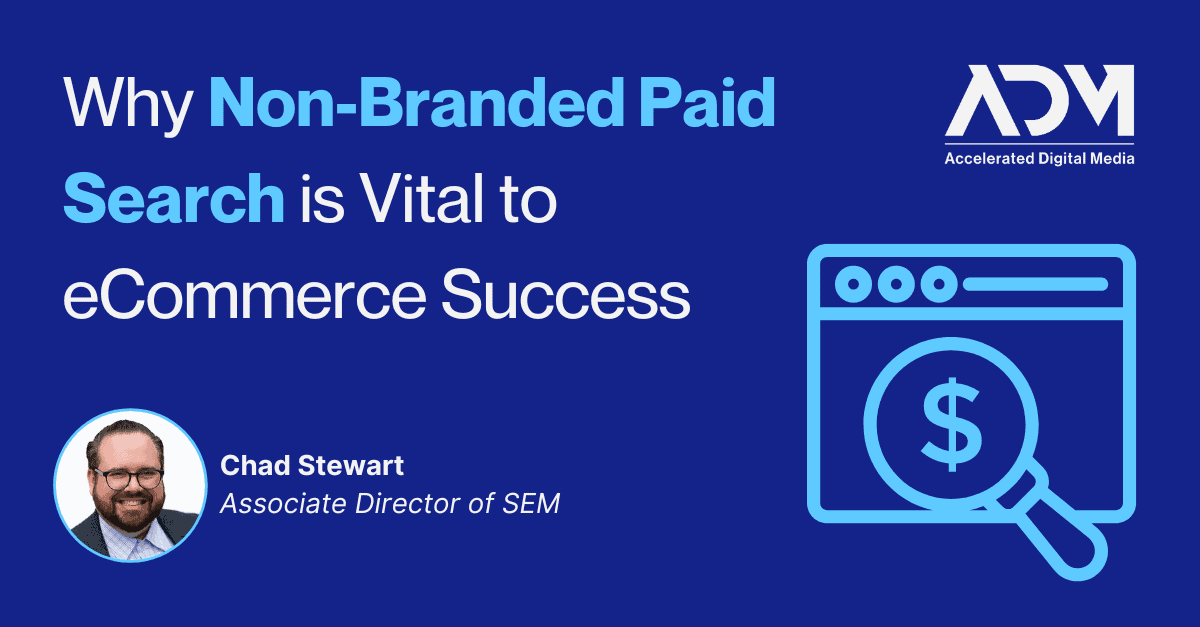Paid search is a vital component of eCommerce digital marketing, but “paid search” is a big tent. It’s important to look at the different aspects of paid search in-depth to learn how you can get the most out of your Google Ads program.
Branded Search is when you bid on the specific name of your brand and branded products—meaning anything that isn’t that is Non-Branded Search: think item types or categories. Non-Branded Search is important because it supplements the middle of the conversion funnel for many businesses. It’s a versatile tool that enables strategic advertisers to create a “choose your own adventure” approach for prospective customers.
This is especially important in eCommerce marketing. Because shoppers are faced with virtually infinite selections for so many products, there are more advertisers than ever who are competing on price exclusively – never actually showcasing any value in their products. This is not sustainable. This sort of “marketing” just creates a race to the bottom.
Non-Branded Search is where advertisers can still reach users who are looking for something more than the lowest price. It’s a place to meet those shoppers where they are and grab their attention. And while those shoppers are paying attention, advertisers have a chance to showcase what makes their product unique or effective.
In this blog, we’ll explain the benefits of a good Non-Branded Paid Search strategy and tactics to employ or avoid when building your own.
What Goals Should Non-Branded Paid Search Help You Accomplish?
Non-Branded Search can be used to create experiences for users that help them to learn more about the things that interest them, and in doing so, should help those users see the value in a brand or its offering.
Non-Branded Search should really be viewed as a research step. While many advertisers still monitor success through performance indicators like Purchase and Revenue, especially for eCommerce, some of the appropriate goals include new user activity (even if not acquisition), pages per session, and time on site. Non-Branded Search is a channel that often reaches users before they’re ready to make a purchase, so the true measure of success is not whether an ad has convinced them to move forward anyway – it’s more about whether they’re engaging with an advertiser’s content and learning more about the brand.
If new users are discovering things they like and appreciating what they’re learning during the “research” or “consideration” stage of the funnel, there’s a good chance they’ll return later to complete the purchase. And it will likely happen through another lower funnel channel, like Brand Search or even direct entry.
How Much Should You Invest in Non-Branded Search Compared to Branded?
There’s not really a one-size-fits-all answer to what a brand should be spending on Non-Branded Search. It’s all about what else is in the marketing mix and how effectively different efforts are supporting a brand’s conversion goals. For example, if a brand spends a significant amount on top-of-funnel tactics, but struggles to drive conversions with their intended bottom-of-funnel tactics, increasing their investment in Non-Branded Search can be a healthy way to bolster what’s happening in the middle of the funnel. Conversely, if a brand has a great conversion rate but struggles to build volume, then there’s an opportunity to invest more in top-of-funnel and middle-of-funnel tactics to build awareness and support shoppers’ consideration habits.
Can Performance Max Campaigns Replace Non-Branded Search?
Google’s Performance Max campaign types have become a dominant force in paid search, with powerful algorithmic targeting and placement that helps them outperform many other campaign types. For eCommerce marketing, Performance Max does have the power to replace Non-Branded Search…technically. But Performance Max doesn’t give advertisers the same level of control over ad delivery as a traditional paid search campaign.
With Non-Branded Search campaigns, advertisers still have the ability to tailor dedicated messaging to specific queries, meaning they can create more of a flow depending on what a user is searching for or whether the user has engaged previously. With Performance Max, all of this is automated, so while Performance Max may still be serving Search ads that functionally look similar to those created in Non-Branded Search, the advertiser has less control over when different messages are shown to users.
ADM’s recommendation is simply to monitor performance, and if Performance Max is spending too significantly and not driving strong results, to increase the focus on Non-Branded Search campaigns to try to steer Performance Max more towards Shopping and bottom-of-funnel search queries and strengthen the middle of our funnel.
How Should You Structure Non-Branded Paid Search Campaigns?
User intent should be top of mind. As mentioned, what gives value to Non-Branded Search as opposed to something like Performance Max is that advertisers can use Non-Branded Search to guide a shopper’s consideration process. That means a user who is searching for something like “pet supplies” should see totally different ads and go through a different landing page than a user searching for “healthy dog food with fresh ingredients.” As an advertiser, it’s really unclear what the user searching “pet supplies” is hoping to find.
In this example, the ad copy should talk about variety and selection, and the landing page should feature a number of options so the user can shop at their own pace. For the user searching “healthy dog food with fresh ingredients,” the ad copy should be really specific to that query. The landing page should feature fresh dog food choices (or at least content about fresh dog food). Non-Branded Search gives advertisers the tools to create those types of search experiences that can add value to a shopper’s consideration period.
Segmentation is important to consider. This is really determined by your marketing mix and budget. The more segmented your campaign structure, the more budget it takes to be effective (Example: if you only have $100/day to spend, you can’t expect 5 campaigns at $20/day to drive much for you). However, in an ideal scenario, an expert marketer will be able to move budget fluidly between different campaign types or Search tactics so you have the flexibility to boost your efforts in areas where you are seeing attrition in the funnel.
What Shouldn’t You Do With Non-Brand Search
The biggest error many advertisers make with Non-Branded Search is taking a “set it and forget it” approach. The strength of Non-Branded Search lies in its ability to be used in tailoring an experience for searchers/shoppers. Many advertisers throw up their original keywords with their original ads, and then just let them run. The only adjustments being made are to bid targets, daily budgets, and maybe pausing the occasional non-converting keyword.
The thing to avoid with Non-Branded Search is failure to be flexible. Review search terms to see what users are searching for and determine whether your keyword/ad copy/landing page mix really aligns with their intention. If not, make adjustments. Good digital marketing involves a combination of expertise, flexibility, and willingness to optimize and adjust. If you’re looking for an expert digital marketing team to guide your paid search strategy to better results, consider reaching out to the ADM team today.




